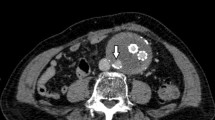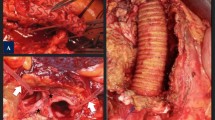Abstract
Purpose
To investigate the natural course of type 2 endoleaks (T2Es) and to identify the risk factors associated with a persistent T2E after endovascular aneurysm repair (EVAR).
Methods
The medical records of patients who underwent EVAR for the treatment of an atherosclerotic abdominal aortic aneurysm between October 2006 and December 2011 at our institute were reviewed. T2Es were diagnosed by contrast-enhanced computed tomography within 4 weeks of EVAR, and patients were followed up at 6 and 12 months. In cases where a T2E was detected, the blood vessels responsible for the T2E were identified and statistically analyzed for their association with a persistent T2E.
Results
We identified T2Es in 111 of 469 patients within 4 weeks of undergoing EVAR. During the follow-up, 41 patients (36.9 %) showed spontaneous resolution of their T2E. The percentage of patients with a T2E was 75.4, 69.2 and 58.0 % at 6, 12 and 24 months, respectively. T2E caused by defects in multiple vessels and T2E associated with the fourth lumbar artery were identified as risk factors associated with a persistent T2E in the univariate analysis. In the multivariate analysis, T2E caused by multiple vessels was identified as the only independent risk factor for a persistent T2E.
Conclusions
We identified T2E caused by multiple vessel failure as an independent risk factor for persistent T2E.


Similar content being viewed by others
References
El Batti S, Cochennec Frédéric, Roudot-Thoraval Françoise, Becquemin Jean-Pierre. Type II endoleaks after endovascular repair of abdominal aortic aneurysm are not always a benign condition. J Vasc Surg. 2013;57:1291–8.
Nolz R, Teufelsbauer H, Asenbaum U, Beitzke D, Funovics M, Wibmer A, et al. Type II endoleaks after endovascular repair of abdominal aortic aneurysms: fate of the aneurysm sac and neck changes during long-term follow-up. J Endovasc Ther. 2012;19:193–9.
Jones JE, Atkins MD, Brewster DC, Chung TK, Kwolek CJ, LaMuraglia GM, et al. Persistent type 2 endoleak after endovascular repair of abdominal aortic aneurysm is associated with adverse late outcomes. J Vasc Surg. 2007;46:1–8.
Steinmetz E, Rubin BG, Sanchez LA, Choi ET, Geraghty PJ, Baty J, et al. TypeIIendoleak after endovascular abdominal aortic aneurysm repair: A conservative approach with selective intervention is safe and cost-effective. J Vasc Surg. 2004;39:306–13.
Timaran CH, Ohki T, Rhee SJ, Veith FJ, Gargiulo NJ III, Toriumi H, et al. Predicting aneurysm enlargement in patients with persistent type II endoleaks. J Vasc Surg. 2004;39:1157–62.
Kodama A, Narita H, Kobayashi M, Yamamoto K, Komori K, et al. Usefulness of POSSUM physiological score for the estimation of morbidity and mortality risk after elective abdominal aortic aneurysm repair in Japan. Circ J. 2011;75:550–6.
Schermerhorn ML, O’Malley AJ, Jhaveri A, Cotterill P, Pomposelli F, Landon BE. Endovascular vs. open repair of abdominal aortic aneurysms in the medicare population. N Engl J Med. 2008;358:464–74.
Harris PL, Vallabhaneni SR, Desgranges P, Becquemin JP, van Marrewijk C, Laheij RJF, for the EUROSTAR Collaborators. Incidence and risk factors of late rupture, conversion, and death after endovascular repair of infrarenal aortic aneurysms: the EUROSTAR experience. J Vasc Surg. 2000;32:739–49.
Silverberg D, Baril DT, Ellozy SH, Carroccio A, Greyrose SE, Lookstein RA, et al. An 8-year experience with type II endoleaks: natural history suggests selective intervention is a safe approach. J Vasc Surg. 2006;44:453–9.
Tuerff SN, Rockman CB, Lamparello PJ, Adelman MA, Jacobowitz GR, et al. Are typeII(branch vessel) endoleaks really benign? Ann Vasc Surg. 2002;16:50–4.
Abularrage CJ, Crawford RS, Conrad MF, Lee H, Kwolek CJ, Brewster DC, et al. Preoperative variables predict persistent type 2 endoleak after endovascular aneurysm repair. J Vasc Surg. 2010;52:19–24.
Marchiori A, Ristow A, Guimaraes M, Scho¨nholz C, Uflacker R. Predictive factors for the development of type ii endoleaks. J Endovasc Ther. 2011;18:299–305.
AbuRahma AF, Mousa AY, Campbell JE, Stone PA, Hass SM, Nanjundappa A, et al. The relationship of preoperative thrombus load and location to the development of type II endoleak and sac regression. J Vasc Surg. 2011;53:1534–41.
Bobadilla JL, Hoch JR, Leverson GE, Tefera G. The effect of warfarin therapy on endoleak development after endovascular aneurysm repair (EVAR) of the abdominal aorta. J Vasc Surg. 2010;52:267–71.
Beeman BR, Murtha Kathy, Doerr K, McAfee-Bennett S, Dougherty MJ, Calligaro KD. Duplex ultrasound factors predicting persistent type II endoleak and increasing AAA sac diameter after EVAR. J Vasc Surg. 2010;52:1147–52.
Arko FR, Rubin GD, Johnson BL, Hill BB, Fogarty TJ, Zarins CK. Type-II endoleaks following endovascular aaa repair: preoperative predictors and long-term effects. J Endovasc Ther. 2001;8:503–10.
Koyanagi T, Kawaharada N, Kurimoto Y, Ito T, Baba T, Nakamura M, et al. Examination of intercostal arteries with transthoracic Doppler sonography. Echocardiography. 2010;27:17–20.
Kasirajan K, Matteson B, Marek JM, Langsfeld M. Technique and results of transfemoral superselective coil embolization of type II lumbar endoleak. J Vasc Surg. 2003;38:61–6.
Abularrage CJ, Patel VI, Conrad MF, Schneider EB, Cambria RP, Kwolek CJ. Improved results using Onyx glue for the treatment of persistent type 2 endoleak after endovascular aneurysm repair. J Vasc Surg. 2012;56:630–6.
Solis MM, Ayerdi J, Babcock GA, Parra JR, McLafferty RB, Gruneiro LA, et al. Mechanism of failure in the treatment of type II endoleak with percutaneous coil embolization. J Vasc Surg. 2002;36:485–91.
Conflict of interest
The authors declare no conflicts of interest.
Author information
Authors and Affiliations
Corresponding author
Rights and permissions
About this article
Cite this article
Maeda, T., Ito, T., Kurimoto, Y. et al. Risk factors for a persistent type 2 endoleak after endovascular aneurysm repair. Surg Today 45, 1373–1377 (2015). https://doi.org/10.1007/s00595-014-1070-6
Received:
Accepted:
Published:
Issue Date:
DOI: https://doi.org/10.1007/s00595-014-1070-6




